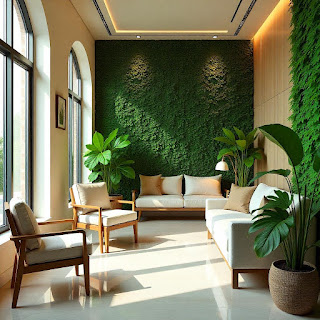Top Interior Design Trends in Dubai to Follow in 2025
Top Interior Design Trends in Dubai to follow in 2025 include sculptural furniture. This type of décor works well for compact restaurants as it creates a tasteful and artistic look in the space.
Soft earthy greens are a popular choice for walls and furniture. They combine beautifully with neutral grey and muted blues for a balanced, organic aesthetic.
1. Biophilic Minimalism
Biophilic minimalism is a design trend that integrates natural elements into interior spaces. It reflects growing research in neuroscience, human intuition and history that our connection to nature is crucial to our health. Incorporating natural colors, textures, shapes and geometries into architecture and interior design is believed to have numerous physical and mental benefits.
With growing stress and pressure emanating from the daily lives of homeowners in Dubai, wellness-centered interiors are gaining more prominence. From meditation rooms to home gyms, the trend is aimed at creating homes that provide a holistic environment for relaxation and healing.
This includes incorporating elements like air purification systems, soothing lighting and furniture with ergonomic features. Open-concept living is also being widely adopted, as it allows for seamless transitions between various areas of the home, thereby enhancing a sense of connectivity and community.
Natural materials are another popular element of the style, with textured surfaces favored over glossy ones. Terrazzo – concrete with coloured marble, granite, quartz, glass, shell or other materials mixed in – is one such material that has been gaining popularity, along with mango wood and reclaimed walnut that feature imperfections.
2. Maximalism
The trend toward maximalism reflects a desire for personalization and self-expression. “With a growing desire to make homes feel truly their own, people are opting to personalize spaces with items that hold meaning or tell a story,” says designer Isabel Ladd.
In this approach, a mix of colors, patterns, and textures are used to create visual depth. The resulting look is both eclectic and elegant. It is particularly suited to contemporary homes with open-concept living and dining areas that can be visually integrated.
This design style is also ideal for compact restaurant interior design in Dubai, as it can accentuate the spaciousness of small spaces. In addition to creating a more open and airy environment, maximalism can add warmth by using materials such as natural woods.
As for color, maximalism allows for a greater range of shades than minimalist designs. In fact, many designers are embracing bold and saturated hues like emerald, sapphire, and violet. They can be incorporated into a room through paint, wallpaper, and furniture or accent pieces. The key is to keep the palette balanced, with a good balance of neutral and colorful elements.
3. Japandi
A fusion of Japanese wabi-sabi and Scandinavian love for nature, Japandi is one of the most popular home interior design trends in Dubai. This style emphasizes simplicity through a neutral color palette and high-quality materials like natural wood and organic textures. Natural hues such as sky blue and dusty pink are ideal for this aesthetic, allowing them to create the desired tranquil ambiance.
This trend also involves blurring the line between indoor and outdoor spaces, which is great for Dubai’s climate. With large sliding glass doors and open-plan living areas, it’s easy to create a seamless transition from the comfort of your home to the outdoors.
For the finishing touches, choose artisanal and handcrafted objects. This will add a sense of personalization to your luxury interior design, making it a true reflection of you and your client’s tastes. For instance, if your client loves the Japandi aesthetic, consider incorporating a custom artwork of their choice. ALMA de LUCE has a collection of hand-painted canvas and boho-inspired wall art that can help you bring this style to life.
4. Sustainable Design
Whether your goal is to court eco-conscious consumers or simply to reduce your environmental footprint, sustainable design has become an integral part of the luxury sector. Sustainable design includes a range of practices and materials that help you cut down on energy consumption and waste.
Moreover, it emphasizes the use of recycled and organic materials that are both environmentally conscious and visually appealing. Organic shapes and curves are a popular choice for furniture. Curved sofa backs, woven wood tables, and sculptural decor are just some of the options that you can try to incorporate into your interior.
The emergence of sustainable designs has also led to the rise of adaptable rooms that effortlessly transition between work, leisure, and social gatherings. Using versatile furniture, modular room dividers, and hidden storage systems allows homeowners to transform their homes as their needs evolve.
5. The Integration of Technology
With the soaring stress levels from modern living, homeowners are giving more importance to wellness-centered residential interior design. This trend features elements like meditation rooms and home gyms that enhance physical and mental health. In addition, it also incorporates amenities like air purification systems that improve the quality of indoor air.
Another key feature of this trend is that it emphasizes the use of eco-friendly materials, such as recycled wood and bamboo. Organic fabrics like wool and cotton are also in demand. Additionally, designers are embracing artisan-made contemporary furniture to help support local craft communities.
Hospital interior design UAE trends 2025 continue to shift away from traditional sterile spaces and toward designs that are both functional and appealing to patients. For example, incorporating greenery and views of natural scenery into patient rooms has been shown to lower stress levels and encourage healing. Similarly, wayfinding systems in hospitals have become more intuitive with digital signage and color-coded signage. These design concepts are helping to elevate the patient experience and boost efficiency.


Comments
Post a Comment